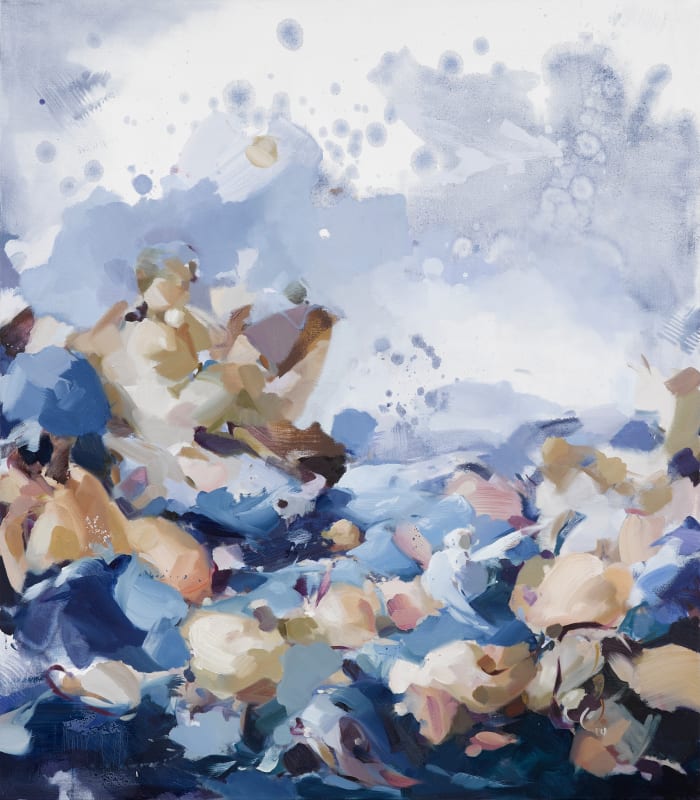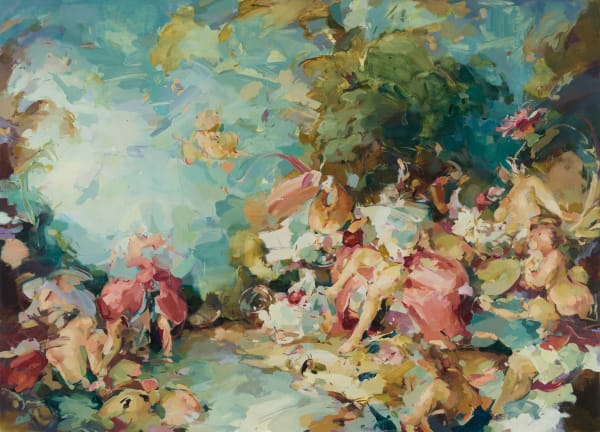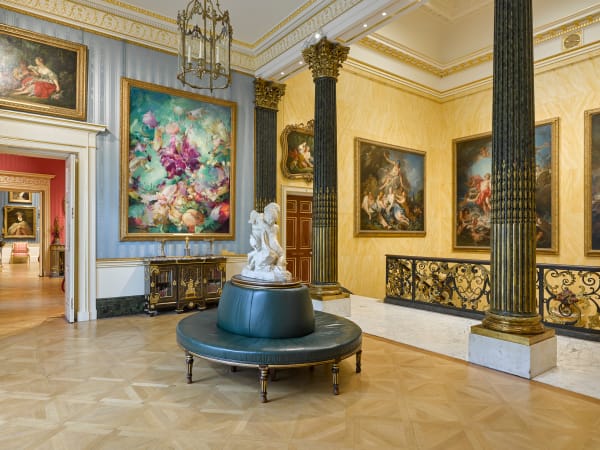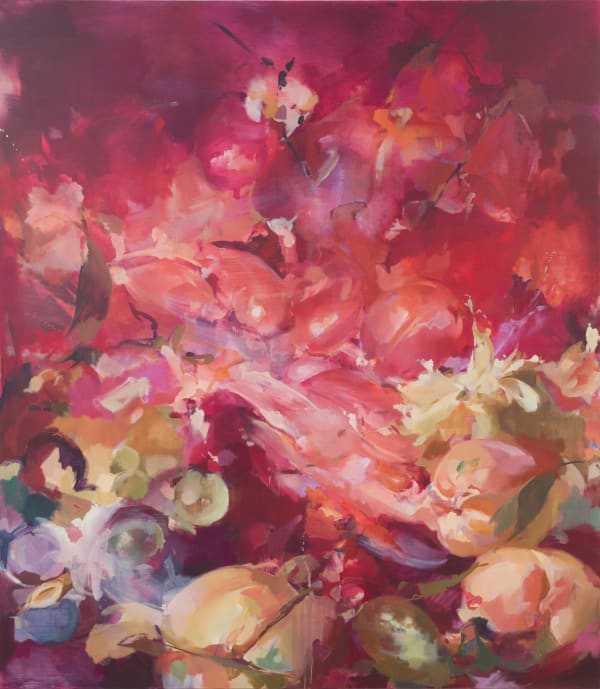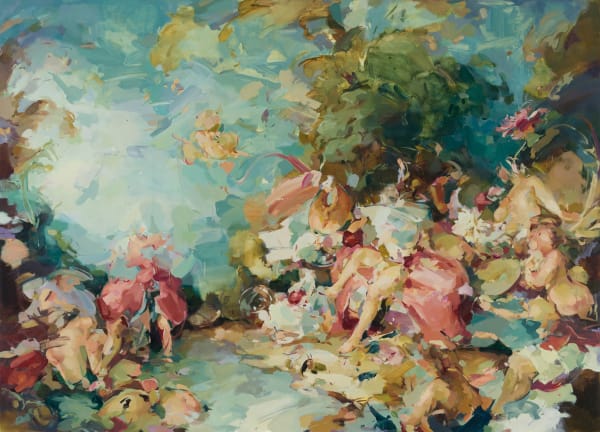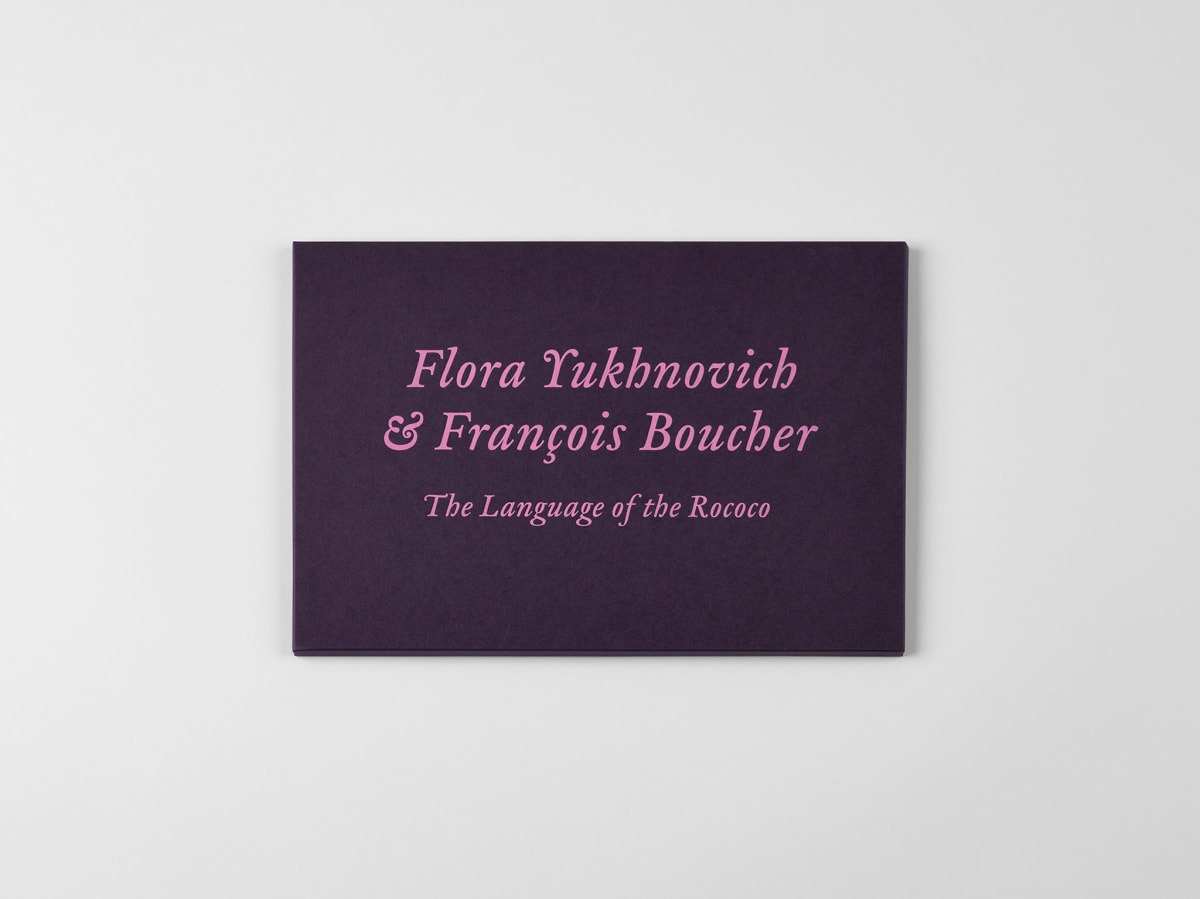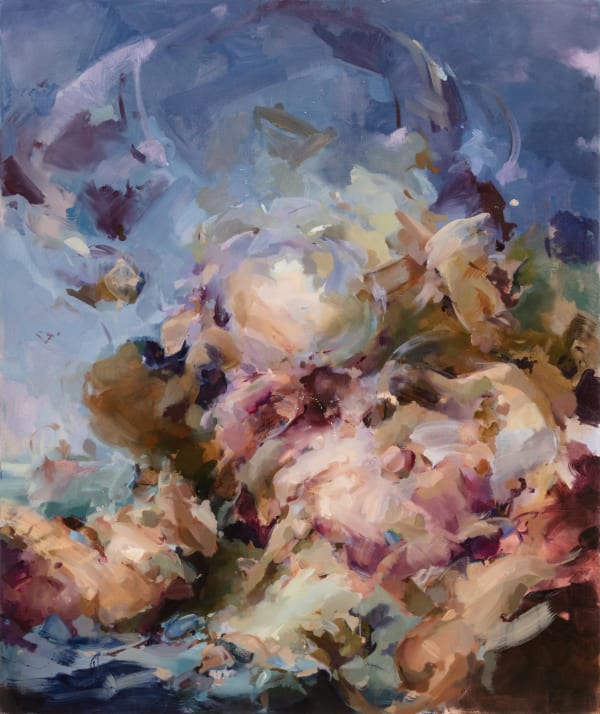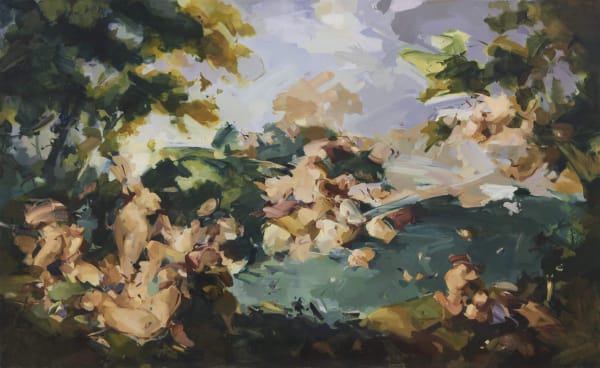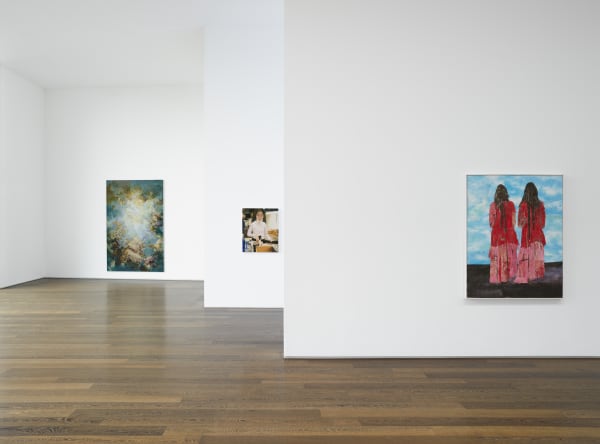Flora Yukhnovich
-
About
Flora Yukhnovich is acclaimed for paintings that, fluctuating between abstraction and figuration, draw on painterly traditions ranging from French Rococo and Italian Baroque to seventeenth-century Dutch still life painting and Abstract Expressionism. In her work, Yukhnovich corrals historical styles and references as multiple rhythms and energies in tandem with allusions to mythology, literature, contemporary film, music, or consumer culture.
While titles often offer a pop-cultural entry-point, inherent in Yukhnovich's painting is an investigation of meaning and materiality, in particular the structures from which gendered readings of subject and process arise. In her paintings drawn from the Rococo tradition, for instance, abstraction is used as a way to resist objectification of the female figure, while her reimagining of floral motifs actively engages with what the artist describes as the 'moralising and controlling messages' contained in traditional depictions of flowers and gardens. Yukhnovich presents a more discursive, questioning vision in which forms never quite resolve. As Eleanor Nairne comments in a 2022 essay on the artist, 'Yukhnovich finds a way to suspend her paintings in flux, the oil having been worked over a number of days so that even when it's finished there is the feeling of barely perceptible movement - like dust motes swirling in the half light, or milk marbling into a cup of tea.' Throughout her work, there is a sense of static, idealised beauty tipping into something less contained, more corporeal and compelling.
-
Biography
Born in 1990, Flora Yukhnovich completed her MA at the City & Guilds of London Art School in 2017. In 2018 she completed The Great Women Artists Residency at Palazzo Monti, Brescia, Italy. Her first solo exhibition was held at Brocket, London, UK, in December 2017 and has exhibited at Parafin, London, UK; GASK, the Gallery of the Central Bohemian Region, Czech Republic; the Jerwood Gallery Hastings, UK and at Blenheim Walk Gallery, Leeds Arts University, UK. Solo exhibitions with Victoria Miro include Thirst Trap, 2022, and The Venice Paintings and Barcarole, both held in 2020.
In 2022, work by the artist featured in the survey exhibition Impressionism: A World View, on view at The Nassau County Museum of Art, NY, USA.
In 2023 Yukhnovich was one of the first artists to take part in a new series of solo exhibitions responding to the collections of the Ashmolean Museum, Oxford, UK, titled Ashmolean NOW (2023–24). Also in 2023, work by the artist featured in the group exhibition New British Abstraction at CICA Vancouver, Canada; and NGV Triennial, National Gallery of Victoria, Melbourne, Australia (2023–24).
In 2024 (5 June–3 November) with the presentation Flora Yukhnovich and François Boucher: The Language of the Rococo, paintings by the artist temporarily replaced two works by François Boucher at the top of the grand staircase on the landing of Hertford House conversing with the surrounding historical works in the Wallace Collection, London, UK.
The artist’s first museum exhibition outside the United Kingdom, titled Flora Yukhnovich: Into the Woods, was held at Ordrupgaard, Charlottenlund, Denmark (2024–25).
Yukhnovich’s work is in permanent collections including the Brooklyn Museum, New York, USA; Dallas Museum of Art, TX, USA; Government Art Collection, London, UK; Hirshhorn Museum, Washington, DC, USA; The Montreal Museum of Fine Arts, Montreal, Canada, and the National Gallery of Victoria, Melbourne, Australia. -
News
-

Flora Yukhnovich: Into the Woods at Ordrupgaard, Denmark
September 18, 2024The works in this exhibition (18 September 2024–19 January 2025) are themed around the fête galante – a genre of painting depicting the wealthy at amorous play in parkland settings that came to prominence with Rococo artists such as Jean-Antoine Watteau and was later revived and reinterpreted by Impressionists including Pierre-Auguste Renoir and Berthe Morisot.Read More -

Flora Yukhnovich talks to Studio International about Wallace Collection presentation
September 6, 2024'My works are paintings, so they are naturally historical things. But I exist now [...] so, I’m always looking at history through a kaleidoscope of contemporary references.'Read More -

Waldemar Januszczak reviews Flora Yukhnovich and François Boucher: The Language of the Rococo at The Wallace Collection
June 16, 2024‘…there are hints of giant rococo fruit and a sense, too, of figures flying through the sky. But who, what and where are withheld. It’s a poem of moods…’Read More -

Flora Yukhnovich is interviewed by the Financial Times
June 14, 2024The artist talks to Jan Dalley about reimagining the Rococo at the Wallace Collection.Read More -

Flora Yukhnovich talks to British Vogue ahead of new works going on view at The Wallace Collection
May 30, 2024Hayley Maitland meets the artist in her London studio to discuss her new paintings, on view at The Wallace Collection from 5 June 2024.Read More -

Flora Yukhnovich and François Boucher: The Language of the Rococo at the Wallace Collection
May 18, 2024From 5 June, paintings by the artist will temporarily replace two works by François Boucher at the top of the grand staircase on the landing of Hertford House.Read More -

Works by Elmgreen & Dragset and Flora Yukhnovich feature in the 2023 NGV Triennial
December 3, 2023This major presentation (3 December 2023–7 April 2024) brings together 120 artists and 100 projects. Flora Yukhnovich's A Taste of a Poison Paradise , 2023,...Read More -

Flora Yukhnovich in conversation at the Ashmolean Museum, Oxford
October 20, 2023Wednesday 25 October at 2pm. In-person tickets are now sold out but book to watch online via the link here . Listen to Flora Yukhnovich...Read More -

Apollo – In the studio with… Flora Yukhnovich
July 11, 2023Flora Yukhnovich has rapidly risen to renown for her lush, layered paintings that reimagine the rococo through the lens of abstraction. ‘It’s capturing what the...Read More -

Flora Yukhnovich features in New British Abstraction at CICA Vancouver
March 16, 2023CICA Vancouver is proud to announce our upcoming group exhibition, New British Abstraction , running from March 16 to April 16, 2023. New British Abstraction...Read More -

Studio Visit: Flora Yukhnovich talks to Artnet ahead of her new exhibition, Thirst Trap
March 1, 2022'I have images from art history and magazine pages scattered all around my studio floor. I like to have them in eyeshot so they fill...Read More -

Doron Langberg and Flora Yukhnovich are featured in Elephant’s Ones to Watch: The Definitive Art Stars of 2021
February 2, 2021Doron Langberg ‘To me, Langberg’s paintings are about the pleasure of looking, at length; they’re about the warmth of real physical human contact, touch and...Read More -

Announcing representation of Flora Yukhnovich
January 19, 2021Victoria Miro is delighted to announce the representation of Flora Yukhnovich. The London-based painter, whose work was first shown at the gallery in a group...Read More -

Flora Yukhnovich speaks with Apollo Magazine
September 23, 2020 Read More
-
-
Books
-
Gallery Exhibitions
-

Flora Yukhnovich: Thirst Trap
1 – 26 Mar 2022 London Gallery INew paintings by the artist draw upon various depictions of the Roman goddess Venus in mythology, art history and contemporary culture.Learn More -

Flora Yukhnovich: Barcarole
12 Sep – 24 Oct 2020 VeniceInspired by a residency with the gallery in Venice, these new works reflect on the influence of the city and Venetian culture.Learn More -

Flora Yukhnovich: The Venice Paintings
19 May – 20 Jun 2020 Miro PresentsAn exhibition of new paintings presented by Victoria Miro in association with Parafin, available to view on Vortic.Learn More -

María Berrío, Caroline Walker, Flora Yukhnovich
7 Jun – 27 Jul 2019 London Gallery IIA summer exhibition featuring three young artists who rethink traditional genres to touch upon themes of migration, the workplace, and the gendered language of painting.Learn More
-
-
Contact Form
Contact us regarding available works by Flora Yukhnovich
